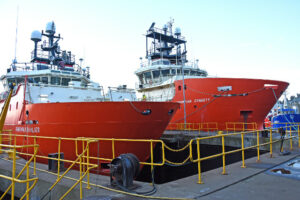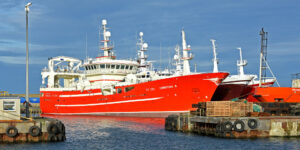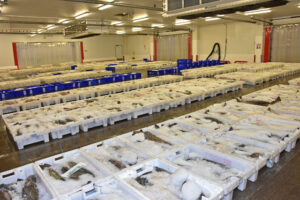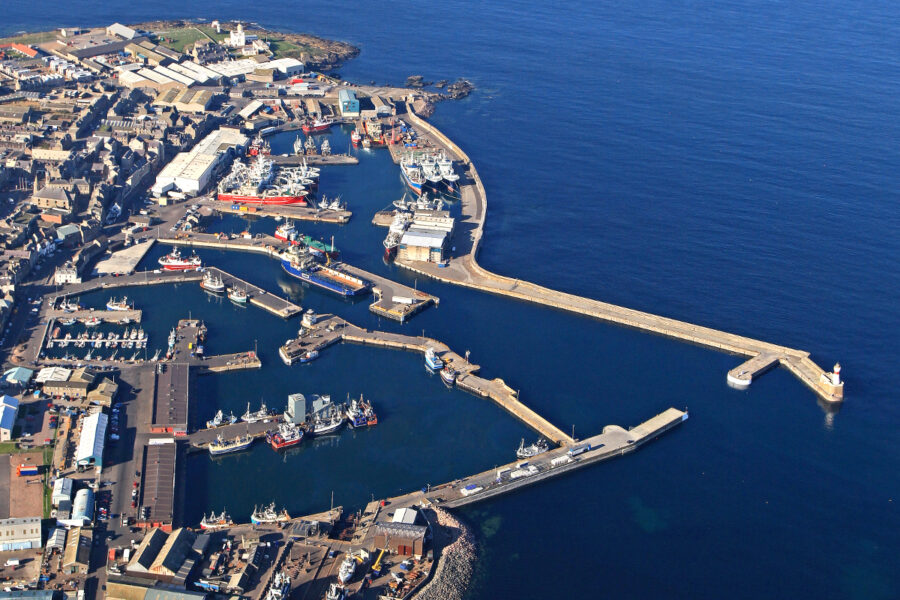
Fraserburgh drydock meets the requirements of larger classes of fishing vessels and supply boats.
Early 16th century Sir William Fraser, sixth laird of Philorth, purchased the lands of Faithlie.
1542 Alexander Fraser, seventh laird of Philorth, received from King James V a charter of the whole fishings opposite his lands, and in 1546 he constructed a convenient harbour. As a result, he received a royal charter erecting Faithlie into a burgh of barony.
9 March 1576 Sir Alexander Fraser, eighth laird of Philorth, laid the first stone of a new harbour. This harbour was bounded by a north breakwater, where the North Pier is today, and a south pier, which forms the landward leg of the middle jetty.
1588 Sir Alexander Fraser, eighth laird of Philorth, obtained a charter erecting Faithlie into a free port and burgh of barony.
1592 Sir Alexander Fraser, eighth laird of Philorth, obtained a grant of novodamus, creating Faithlie a burgh of regality with a free port, and ordaining that it should henceforth be called the Burgh and Port de Fraser. Thus the port of Fraserburgh was born.
1809-1810 New North Pier completed.
1815-1817 The start of the herring-curing industry in Fraserburgh saw bumper landings of herring through the port.

Midwater trawlers berthed in Balaclava basin.
1818 The construction of the South Pier was started, and the first direct local harbour authority, as constituted by an act of parliament, met for the first time – the first Fraserburgh harbour commissioners.
1850 Construction began of a new north breakwater later named Balaclava Pier (after the Crimean War).
By 1873 The prosperity generated by the boom in the herring fishery combined with the coming of the railway in 1865 made further enlargement of the harbour a matter of urgency.
23 October, 1875 The foundation stone of a new breakwater was laid by Lord Saltoun.

Whitefish laid out ready for auction in one of Fraserburgh’s two modern fishmarkets.
1875-1887 Extensive improvements made to the Balaclava and North harbours, including the provision of a lifeboat slip.
1879 First election of harbour commissioners, with Lord Saltoun’s factor as chair of the harbour board until 1892.
c. 1881-1902 Construction of the fishmarket at South Pier.
1892-1975 After the passing of the Burgh Police Act in 1892, the chairman of the commissioners was the provost of Fraserburgh until
town councils disappeared in 1975.
1894-1896 Balaclava harbour deepened.
1908 Start of construction of the Faithlie harbour, with storm gates across the entrance. These were swept away shortly after completion in 1914.

The new Blacksands Quay provides an extensive area for net repairs.
By 1931 Slipway at Faithlie basin had been built.
1959 Fishmarket built on Walker Quay at Faithlie basin.
1963 Opening of reconstructed Faithlie basin.
1977 Balaclava harbour deepened for the second time, along with the main entrance channel.
1981 Slipway at Faithlie basin replaced by a new hydraulic slipway.
1987 New fishmarket built on Finlayson Quay alongside existing one on Walker Quay.
1989 Original fishmarket at Walker Quay replaced with a new one.
1992 Deepening of inner Balaclava, and building of Queen Elizabeth II drydock.

Fraserburgh’s modern shiplift and six-berth refit facility attracts a wide range of local and visiting vessels.
1997 Main channel and Balaclava harbour deepened.
2000 Six-berth shiplift constructed at Faithlie basin.
2002-2003 Deepening of approaches to Fraserburgh harbour.
2012 Deepening of North harbour and creation of Blacksands Quay.
2018 Master plan exercise undertaken by commissioners, and selection of Fraserburgh as preferred port for Moray offshore wind project (MOWEL).








